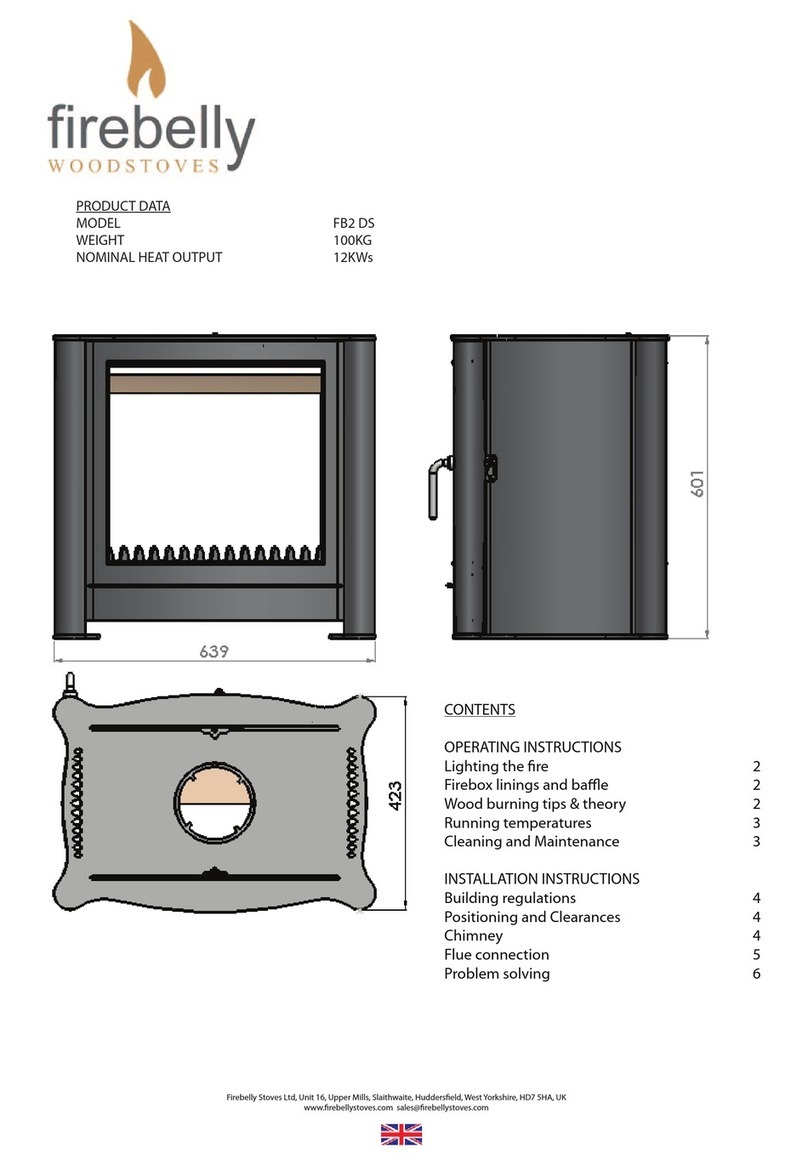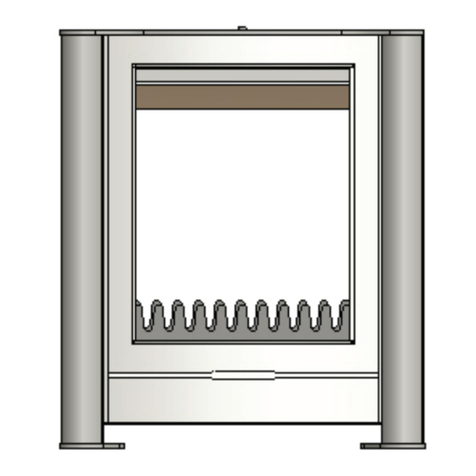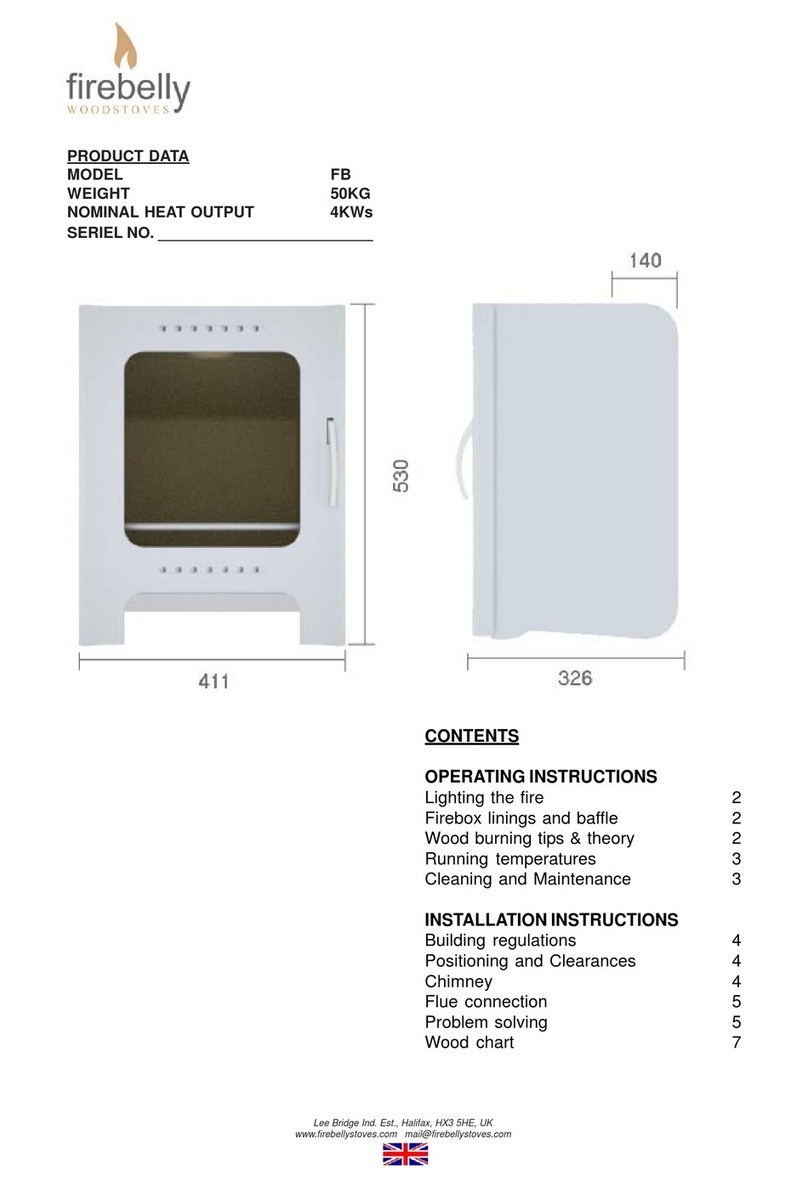Firebelly T1 Product guide

1
Operating & Installation Instructions
Firebelly T1 –4 kW
Firebelly Production Facility:
Unit 16 Upper Mills,
Canalside
Slaithwaite
Huddersfield
West Yorkshire
U.K.
HD7 5HA
Firebelly Sales Office and Showroom:
Units 6 & 7
Riverside Shopping Centre
Huddersfield Road
Holmfirth
West Yorkshire
U.K.
HD9 3AZ

2
Important Points
1. Firebelly recommends only HETAS registered installer fits this appliance
2. Local Regulations, including those referring to National and European Standards need to be
complied with when installing this appliance.
3. This appliance surface becomes hot when in use, always use a suitable fireguard if young
people, the elderly or infirmed persons are present.
4. Do not place combustible objects on or around the appliance.
5. No unauthorised changes to the construction of this appliance must be carried out.
6. Firebelly recommended that the chimney or flue be checked and swept annually and the
appliance must be maintained on an annual basis by a competent engineer.
7. This appliance must not share a chimney or flue with another appliance.
8. This appliance has been constructed and CE approved for the burning of wood only
9. This appliance must not be used as an incinerator and only the recommended wood must be
used. Never use liquid fuels in this appliance.
10. This appliance has been designed for intermittent operation.
11. Keep all areas underneath the stove clear from debris or other materials in order to keep the
air inlets clear.
12. The top air control takes its air from the top-side behind the door, always keep this area clear
to aid the combustion process.
13. The weather conditions on any given day can affect the burning performance of the stove. If
there are obstacles that include other buildings positioned around the flue, the turbulent
Air can cause the appliance to run smoky.
Firebelly T1 –4 kW

3
Firebelly T1 –4 kW
Lighting the Appliance
For best results lighting this appliance Firebelly recommends the following procedure:
1. Set Air controls to ‘fully open’.
2. Place firelighters or paper in the bottom of the stove and add dry kindling wood on top.
3. Light the firelighters or paper and leave the door slightly open to allow the fire to establish
and prevent condensation on the glass.
4. Once the fire has established, add larger pieces of wood. Do not smother the fire with too
many logs.
5. Close the door.
13. An oversized chimney or flue can also affect the appliance in a similar fashion on calm days.
Damp or rainy days can also affect the lighting and burning efficiency of this appliance. In
order to counteract these problems, Firebelly recommends only using good quality, dry
kindling to start the fire. Initially burn the appliance, at a high temperature and fit a rain
cowl to prevent moisture running down the flue/chimney. If, for any reason the appliance
emits smoke into the room, close both air adjusters and ventilate the room immediately.
Running the Appliance
1. Once the fire has established move the bottom air control to fully ‘shut’.
2. Leave the top Air Control fully open to begin with and then control the rate of burn by adjusting
this control. Please note, Firebelly recommend that the top air control is not run fully shut for
any length of time in order to avoid the glass door becoming discoloured.
3. Re-Fuel little and often rather than overfilling the stove. Firebelly, recommend opening the
bottom and top air control fully when re fuelling the stove in order to establish the fir on new
fuel.
4. Please note that woods burns best on a bed of embers.
Important Points (cont…)

4
Firebelly T1 –4 kW
Running the Appliance (cont…)
5. Do Not over fuel the appliance.
6. If the stove has not been used for a long period of time, Firebelly recommends that the flue
connector is checked prior to light up by a visual inspection.
7. The door should be closed at all times except, on ignition, refuelling and the removal of residue.
8. If a chimney fire occurs, close the top and bottom air controls immediately and evacuate the
building. Call the Fire Brigade and do not re-enter the building until it is confirmed safe.
9. Do not use the appliance after a chimney fire until the chimney/flue system has been inspected
and swept by a registered chimney sweep and confirming the system is structurally sound and
free from obstruction.
Burning Tips And Hints
Fuel Quality
1. It is essential to maintain the correct performance of your stove to burn only well seasoned
wood with a water content of less than 20%.
2. Firebelly recommend that all wood intended for use on the appliance be stored for a period of
12 months in a dry, ventilated space.
3. Seasoned wood feels lighter than timber with high moisture content.
4. The wood should not have moss or any other growth on it.
5. Wood with high moisture content will make it difficult to start the stove and maintain its
efficiency, it will also add to a rapid creosote build up in the chimney or flue and provide a low
heat output.
6. Well-seasoned wood usually has a cracked appearance on the end of the log.

5
Firebelly T1 –4 kW
Burning Tips And Hints (cont…)
Flue/Chimney
1. The primary function of a chimney or flue is to safely remove smoke. Combustion fumes and
gases from the house.
2. The secondary function of a chimney/flue is to provide a positive up draught in the appliance to
ensure the fire in the stove is maintained.
Poor Performance that can be attributed to bad chimney/flues includes:
1. Difficulty in establishing a fire and maintaining a fire for a long period of time
2. Excessive fuel usage
3. Poor efficiency due to low heat output
4. Excessive smoke entering the room when re-fuelling with doors open.
Maintenance & Cleaning
1. Never carry out any cleaning until the stove is cold.
2. Use a soft brush or vacuum to clean the external parts of the stove, do not use abrasives or spirit
based substances, as this will remove the paint finish.
3. Touch up paint can be purchased through your approved Firebelly dealer. Do not use the spray
paint on a hot appliance.
4. The stove outer panels may be cleaned with a slightly damp cloth but always ensure that the
stove is completely dry to avoid the risk of rust.
5. Do not clean the glass whilst it is hot, always ensure that it is completely cool and use either a
clean, soft cloth with a cream based cleaner, alternatively a dry newspaper or paper towel can
be used. Always ensure that the glass is fully dried before reusing the stove.
6. If the appliance is used often Firebelly recommend that the chimney/flue be swept at least once
a year by a competent and qualified sweep.
7. The connecting flue between the stove and the chimney must also be cleaned regularly.
8. When the stove is not in use during the summer months Firebelly recommends that the air
controls be left fully open to ensure there is no build up of moisture inside.
9. Only use recommended original parts supplied by the manufacturer.

6
Firebelly T1 –4 kW
Technical Specification
Model –Firebelly T1
Weight –60 kgs
Nominal Heat Output –4.8 kW
CO emission (@13% Oxygen) –0.68
Flue Gas Temperature –203 Degrees Celcius
Flue Gas Mass Flow (g/s) –5.1
Minimum Flue Draught for Nominal Heat Output –12 Pa
Refuelling Period –1 Hour

7
Firebelly T1 –4 kW
Installation
Building Regulations
This stove must be fitted to the current rules in force in order to comply with the latest building
regulations. Only a competent HETAS registered installer must fit the stove and flue liner is
recommended.
Flue/Chimney
The construction of the chmeny/flue must have a surface area equivalent to 125mm (5” diameter). A
flexible liner may be used if certified by its manufacturer for solid fuel applications.
This appliance is not suitable for installation in a shared flue system. The appliance must have its own
chimney/flue.
If it is necessary to install a register plate it must meet the current Building Regulations.
The minimum height of the flue must be 4.5 meters measured from the Hearth to the top of the flue.
Firebelly recommend sweeping the chimney before installation and if the chimney/flue has been used
for burning solid fuel in the past, a further sweep of the chimney is recommended after six weeks from
installation to ensure that any sooty deposits not previously removed are completely removed. Always
provide a suitable access in order to remove debris from the chimney/flue.
After installation the installer must always check the flue draught with all windows and doors closed
and any extraction fans operating at maximum speed.
Ventilation
The Firebelly T1 stove is rated at 4.8 kW output so therefore in normal conditions does not require
purpose made ventilation into the room it is installed in.
Hearth Requirements
The Firebelly T1 requires a non-combustoible hearth of at least 12mm thick and the minimum
dimensions shown.
(500mm from the rear and 400mm to sides)
The floor must have a suitable load bearing capacity for 60 kgs.

8
Firebelly T1 –4 kW
Requirements for Walls
The walls constructed around the stove must be of a non combustible material and must be at least
150mm away from the stove at any point. Safe distance from combustible material is 500mm to rear of
appliance and 400mm to side of appliance.
Commissioning
To commission the appliance:
1. Ensure that all Firebrick insulation is in place
2. Check the door seal soundness and the operation of the air inlet controls. Close the air inlets.
Close all doors and windows in the room where the appliance is fitted.
3. Warm the chimney/flue with a blowlamp or similar for approximately ten minutes.
4. Place a smoke pellet in the centre of the appliance.
5. Close the door and check that the smoke is drawn into the flue outlet.
6. If there are any extractor fans in adjacent rooms, the above test must be repeated with the fans
running at maximum and all interconnecting doors open. Check to see if there are any effects on
the appliance when the fans are running.
7. If the appliance fails the test, check the suitability and connection of the chimney/flue.
8. Once the smoke test is satisfactorily completed, light the appliance as per the user instructions
and ensure that no products of combustion enter the room.
9. Explain the safe operation of the appliance and the use of the controls to the user and the
importance of only using suitable fuels.
10. Explain the Cleaning and Maintenance requirements.

9
Firebelly T1 –4 kW
Maintenance & Servicing
At the end of the traditional heating season, late spring early summer, inspect and clean the appliance
as follows:
1. Allow appliance to cool
2. Remove all insulating bricks carefully as they become fragile after a period of time. Remove the
top insulator first, then the rear piece, lift out the grate assembly with its insulating pad, then
remove the two side insulating panels. Clean all the insulating panels with a soft brush and place
to one side. Replace any damaged components.
3. Inspect grate assembly, clean and inspect for any cracks or other damage.
4. Remove any ash and debris from inside the appliance.
5. Check the flue outlet is clear from any blockage and that the integrity of the connection is in
tact.
6. Check the door and glass seal, replace if damaged or worn.
7. Clean the glass door with a good quality glass cleaner. Do not use an abrasive pad to remove any
deposits.
8. Replace the liners and grate taking care not to damage the liners in this process.
9. Always use genuine Firebelly parts when replacing any components.
Firebelly Production Facility:
Unit 16 Upper Mills,
Canalside
Slaithwaite
Huddersfield
West Yorkshire
U.K.
HD7 5HA
Firebelly Sales Office and Showroom:
Units 6 & 7
Riverside Shopping Centre
Huddersfield Road
Holmfirth
West Yorkshire
U.K.
HD9 3AZ
Tel: +44(0) 1484 680502 Fax:+44(0) 1484 690574
Table of contents
Other Firebelly Wood Stove manuals
Popular Wood Stove manuals by other brands

RAIS
RAIS attika NEXO 100 GAS installation guide

WoodPro
WoodPro WS-TS-1500 owner's manual

Contura
Contura C 586W installation instructions

Palazzetti
Palazzetti EVA GENERAL INFORMATION - WARNINGS - INSTALLATION - MAINTENANCE

Lopi
Lopi 1250 Republic owner's manual

Panadero
Panadero CAPRI 3V Usage and maintenance instructions














